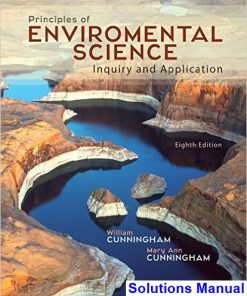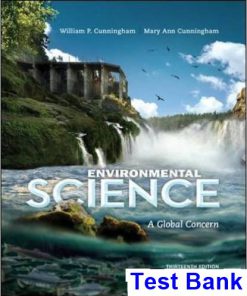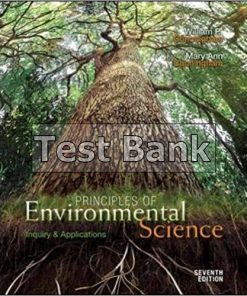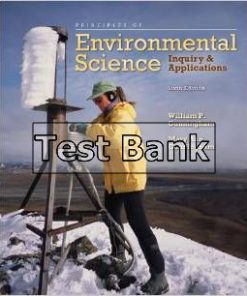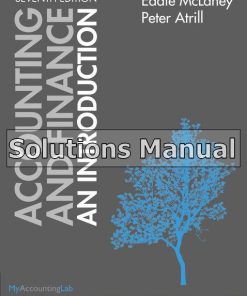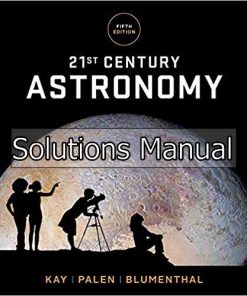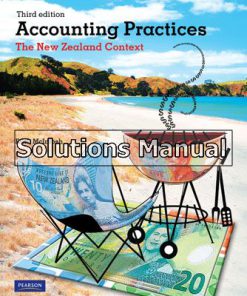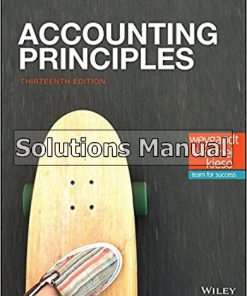Principles of Environmental Science Companion Site 6th Edition Cunningham Solutions Manual
$26.50$50.00 (-47%)
Principles of Environmental Science Companion Site 6th Edition Cunningham Solutions Manual.
You may also like
This is completed downloadable of Principles of Environmental Science Companion Site 6th Edition Cunningham Solutions Manual
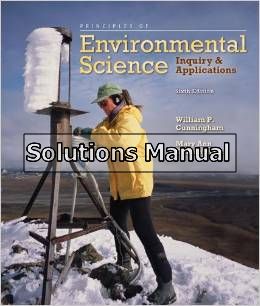
Product Details:
- ISBN-10 : 0073383244
- ISBN-13 : 978-0073383248
- Author:
Rather than the 25 to 30 chapters found in most environmental science textbooks, the authors have limited Principles of Environmental Science: Inquiry and Applications to 15 chapters–perfect for the one-semester, non-majors environmental science course. True to its title, the goal of this concise text is to provide an up-to-date, introductory view of essential themes in environmental science along with offering students numerous opportunities to practice scientific thinking and active learning.
Table of Content:
Chapter 1 Understanding Our Environment 1 Objectives 1 Learning Online 1 Dredging the Hudson River 2 Understanding Our Environment 3 A Marvelous Planet 3 What Is Environmental Science? 4 Science As a Way of Knowing 4 COOPERATION AND INSIGHT IN SCIENCE 5 Scientific Design 6 Deductive and Inductive Reasoning 6 Hypotheses and Theories 6 Modeling and Natural Experiments 7 Statistics and Probability 8 Investigating Our Environment What Are Statistics, and Why Are They Important? 8 Paradigms and Scientific Consensus 9 Pseudoscience and Baloney Detection 10 Thinking About Thinking 10 Approaches to Knowledge and Meaning 11 Applying Critical Thinking 12 Investigating Our Environment A Skeptical Environmentalist? 12 Some Clues for ?Unpacking? an Argument 13 Using Critical Thinking 13 A Brief History of Conservation and Environmentalism 14 Historic Roots of Nature Protection 14 Pragmatic Resource Conservation 14 Moral and Aesthetic Nature Preservation 15 Modern Environmentalism 15 Global Concerns 16 Current Environmental Conditions 16 Signs of Hope 18 Human Dimensions of Environmental Science 19 Rich and Poor Countries 19 A Fair Share of Resources? 20 Sustainability 21 Indigenous Peoples 21 Chapter 2 Principles of Ecology: Matter, Energy, and Life 25 OBJECTIVES 25 Learning Online 25 Measuring Energy Flows in Cedar Bog Lake 26 Principles of Matter and Energy 26 What Is Matter? 27 What Is Energy? 27 Thermodynamics and Energy Transfers 28 The Building Blocks of Earth and Life 28 Atoms, Molecules, and Compounds 28 Chemical Reactions 29 Acids and Bases 30 Organic Compounds 31 Cells: The Fundamental Units of Life 31 The Miracle of Water 32 Sunlight: Energy for Life 33 How Does Photosynthesis Capture Energy? 33 Investigating Our Environment Remote Sensing, Photosynthesis, and Material Cycles 35 Energy and Matter in the Environment 36 Food Chains, Food Webs, and Trophic Levels 36 Ecological Pyramids 38 Biogeochemical Cycles and Life Processes 38 The Hydrologic Cycle 38 The Carbon Cycle 39 The Nitrogen Cycle 40 The Phosphorus Cycle 43 The Sulfur Cycle 43 Investigating Our Environment Environmental Chemistry of Phosphorus 44 Chapter 3 Populations, Communities, and Species Interaction 48 Objectives 48 LEARNING ONLINE 48 Darwin and the Theory of Evolution 49 Who Lives Where, and Why? 50 Critical Factors and Tolerance Limits 50 Evolution: Natural Selection and Adaptation 51 Speciation 51 The Taxonomic Naming System 53 The Ecological Niche 53 What Are Weedy Species? 54 Species Interactions 55 Predation 55 Competition 56 Symbiosis 57 Defensive Mechanisms 57 Keystone Species 58 Population Dynamics 59 Population Growth 59 Boom and Bust Population Cycles 60 Growth to a Stable Population 60 Limiting Factors 61 K-adapted and r-adapted Species 61 Community Properties 62 Productivity 62 Abundance and Diversity 63 What Can You Do? Developing a Sense for Where You Live 64 Complexity, Resilience, and Stability 64 Community Structure 64 Case Study Biodiversity and Stability 66 Edges and Boundaries 67 Communities in Transition 68 Ecological Succession 68 CLIMAX COMMUNITIES OR INDIVIDUALISTIC SUCCESSION? 69 Introduced Species and Community Change 70 Chapter 4 Human Populations 74 Objectives 74 Learning Online 74 A Billion People and Growing 75 Population Growth 75 Human Population History 76 Population Doubling Times 76 Limits to Growth: Some Opposing Views 77 Malthusian Checks on Population 77 Malthus and Marx Today 78 Can Technology Make the World More Habitable? 78 Could More People Be Beneficial? 79 Human Demography 79 How Many of Us Are There? 79 Investigating Our Environment Interpreting Graphs 80 Fertility and Birth Rates 81 Mortality and Death Rates 82 Life Span and Life Expectancy 82 Living Longer: Demographic Implications 83 Population Growth: Opposing Factors 84 Pronatalist Pressures 84 Birth Reduction Pressures 85 Demographic Transition 86 Development and Population 86 An Optimistic View 87 A Pessimistic View 87 A Social Justice View 87 INFANT MORTALITY AND WOMEN?S RIGHTS 87 Family Planning and Fertility Control 88 Case Study Family Planning in Iran 89 Traditional Fertility Control 89 Current Birth Control Methods 89 New Developments in Birth Control 90 The Future of Human Populations 91 Chapter 5 Biomes and Biodiversity 95 Objectives 95 Learning Online 95 Coral Reefs Threatened 96 Terrestrial Biomes 96 Deserts 97 Grasslands: Prairies and Savannas 99 Tundra 99 Conifer Forests 100 Broad-Leaved Deciduous Forests 101 Mediterranean/Chaparral/Thorn Scrub 101 Tropical Moist Forests 102 Tropical Seasonal Forests 102 Marine Ecosystems 103 The Open Ocean 104 Coastal Regions: Reefs, Estuaries, Shoals, and Mangroves 104 Tidal Environments and Barrier Islands 105 Freshwater Ecosystems 106 Lakes 106 Wetlands 106 Streams and Rivers 107 Biodiversity 107 How Many Species Are There? 107 Biodiversity Hot Spots 108 HOW DO WE BENEFIT FROM BIODIVERSITY? 108 Food 108 Drugs and Medicines 109 Ecological Benefits 109 Aesthetic and Cultural Benefits 109 What Threatens Biodiversity? 110 Natural Causes of Extinction 110 Human-Caused Reductions in Biodiversity 110 Habitat Destruction 111 Fragmentation 111 Invasive Species 112 Investigating Our Environment Using GIS to Protect Biodiversity 113 Pollution 114 Population 115 Overharvesting 115 Commercial Products and Live Specimens 116 Predator and Pest Control 117 Endangered Species Management And Biodiversity Protection 117 Hunting and Fishing Laws 117 What Can You Do? Don?t Buy Endangered Species Products 117 The Endangered Species Act 118 Recovery Plans 118 Reauthorizing the Endangered Species Act 120 Habitat Protection 120 International Wildlife Treaties 121 Chapter 6 Environmental Conservation: Forests, Grasslands, Parks, and Nature Preserves 124 Objectives 124 Learning Online 124 Protecting Forests to Preserve Rain 125 World Forests 126 FOREST DISTRIBUTION 126 Forest Products 127 Tropical Forests 128 Temperate Forests 130 What Can You Do? Lowering Your Forest Impacts 130 Investigating Our Environment Forest Thinning and Salvage Logging 133 Rangelands 134 Range Management 134 Rangelands in the United States 135 New Approaches to Ranching 135 Parks and Nature Preserves 136 North American Parks 136 Park Problems 137 Wildlife Issues 138 Parks as Ecosystems 138 Case Study Reintroducing Wolves to Yellowstone 139 World Parks And Preserves 140 Marine Preserves 141 Protecting Natural Heritage 141 Size and Design of Nature Preserves 141 Conservation and Economic Development 142 Indigenous Communities and Biosphere Reserves 143 What Can You Do? Being a Responsible Ecotourist 144 Wilderness Areas 144 Wildlife Refuges 145 International Wildlife Preserves 145 Chapter 7 Food and Agriculture 149 Objectives 149 Learning Online 149 Golden Rice 150 FOOD AND NUTRITION 151 Chronic Hunger and Food Security 151 Famines and Acute Food Shortages 152 Malnutrition and Obesity 153 Eating a Balanced Diet 154 Major Food Sources 155 Major Crops 155 Meat and Dairy 155 Seafood 157 Soil: A Renewable Resource 157 Soil Organisms 158 Soil Profiles 159 Soil Types 159 Ways We Use and Abuse Soil 159 Land Resources 159 Land Degradation 160 Erosion: The Nature of the Problem 161 Mechanisms of Erosion 161 Erosion Hot Spots 163 Other Agricultural Resources 163 Water 163 Fertilizer 163 Energy 164 Pest Control 164 New Crops and Genetic Engineering 165 The Green Revolution 165 What Can You Do? Reducing the Pesticides in Your Food 165 Genetic Engineering 166 Pest Resistance and Weed Control 166 Is Genetic Engineering Safe? 167 Sustainable Agriculture 168 SOIL CONSERVATION 168 Managing Topography 168 Providing Groundcover 169 Reduced Tillage 169 Case Study Shade-Grown Coffee and Cocoa 170 Low-Input Sustainable Agriculture 171 Chapter 8 Environmental Health and Toxicology 175 Objectives 175 Learning Online 175 The Cough Heard Round the World 176 Environmental Health 176 Global Disease Burden 176 Emergent and Infectious Diseases 178 Funding Health Care 180 Ecological Diseases 180 Antibiotic and Pesticide Resistance 181 Diet 182 Toxicology 182 What Can You Do? Tips for Staying Healthy 183 Endocrine Hormone Disrupters 185 Movement, Distribution, and Fate of Toxins 186 Solubility and Mobility 186 Exposure and Susceptibility 186 Bioaccumulation and Biomagnification 187 Persistence 187 What Do You Think? Children?s Health 188 Chemical Interactions 189 Mechanisms for Minimizing Toxic Effects 189 METABOLIC DEGRADATION AND EXCRETION 189 Repair Mechanisms 190 Measuring Toxicity 190 Animal Testing 190 Toxicity Ratings 191 Acute versus Chronic Doses and Effects 191 Detection Limits 192 Risk Assessment and Acceptance 192 Understanding Risks 193 Accepting Risks 193 Establishing Public Policy 194 Chapter 9 Air: Climate and Pollution 198 Objectives 198 Learning Online 198 What?s Happening to Our Weather? 199 The Atmosphere and Climate 199 Energy and the Greenhouse Effect 200 Convection and Atmospheric Pressure 201 Why Does It Rain? 202 The Coriolis Effect and Jet Streams 203 Ocean Currents 204 Seasonal Winds and Monsoons 204 Climate Change 205 El Nino/Southern Oscillation 206 Human-Caused Global Climate Change 207 Climate Skeptics 207 Sources of Greenhouse Gases 207 What Do You Think? Science and Uncertainty in Climate Change 208 Current Evidence of Climate Change 209 Winners and Losers 210 INVESTIGATING OUR ENVIRONMENT SATELLITE IMAGES 211 International Climate Negotiations 212 Controlling Greenhouse Emissions 212 Climate and Air Pollution 213 Major Kinds of Pollutants 214 Sources and Problems of Major Pollutants 215 Indoor Air Pollution 216 Interactions Between Climate Processes and Air Pollution 217 Long-Range Transport 217 Stratospheric Ozone Depletion 217 Signs of Progress 219 Urban Climates 219 Effects of Air Pollution 220 Human Health 220 Plant Pathology 220 Visibility Reduction 221 Acid Deposition 221 Air Pollution Control 222 Reducing Production 222 Clean Air Legislation 223 Clear Skies 224 Current Conditions and Future Prospects 225 Air Pollution in Developing Countries 225 Signs of Hope 225 Chapter 10 Water: Resources and Pollution 229 Objectives 229 Learning Online 229 Sharing the Chattahoochee 230 WATER RESOURCES 230 Where Does Our Water Come From? 231 Major Water Compartments 232 Groundwater 232 Rivers, Lakes, and Wetlands 233 The Atmosphere 234 Water Availability and Use 234 Water-Rich and Water-Poor Countries 234 Water Use 235 Quantities of Water Used 235 Freshwater Shortages 236 A Precious Resource 236 Depleting Groundwater 236 Can We Increase Water Supplies? 237 Dams, Reservoirs, and Canals 237 Case Study Water Wars on the Klamath 238 Price Mechanisms and Water Policy 239 Water Management and Conservation 240 You Can Make a Difference: Domestic Conservation 240 Signs of Progress 241 What Can You Do? Saving Water and Preventing Pollution 241 Water Pollution 241 Point and Nonpoint Source Pollution 241 Biological Pollution 242 Inorganic Pollutants 245 Organic Chemicals 245 Case Study Arsenic in Drinking Water 246 SEDIMENT AND THERMAL POLLUTION 246 Water Quality Today 247 Surface Waters in the United States and Canada 247 Surface Waters in Other Countries 249 Ocean Pollution 251 Pollution Control 252 Nonpoint Sources and Land Management 252 Sewage Treatment 252 Remediation 254 Water Legislation 255 The Clean Water Act 255 Chapter 11 Environmental Geology and Earth Resources 259 Objectives 259 Learning Online 259 Radioactive Waste Disposal at Yucca Mountain 260 A Dynamic Planet 261 A Layered Sphere 261 Tectonic Processes and Shifting Continents 261 Minerals and Rocks 262 Rock Types and How They Are Formed 262 Weathering and Sedimentation 264 Economic Geology and Mineralogy 265 Metals 265 Nonmetal Mineral Resources 265 Fuels: Oil, Coal, and Uranium 266 Environmental Effects of Resource Extraction 267 MINING 267 What Can You Do? Coal-Bed Methane 268 Processing 269 Conserving Geologic Resources 270 Recycling 270 Steel and Iron Recycling: Minimills 270 Substituting New Materials for Old 271 Geologic Hazards 271 Earthquakes 271 Volcanoes 272 Floods 273 Erosion 274 Chapter 12 Energy 278 Objectives 278 Learning Online 278 Sea Power 279 Energy Sources and Uses 279 Current Energy Sources 280 Per Capita Consumption 280 How We Use Energy 280 Fossil Fuels 282 Coal 282 Oil 283 Oil Shales and Tar Sands 284 Natural Gas 285 Nuclear Power 285 How Do Nuclear Reactors Work? 286 Nuclear Reactor Design 286 Nuclear Wastes 287 ENERGY CONSERVATION 288 Using Energy More Efficiently 288 What Can You Do? Some Things You Can Do to Save Energy 289 Cogeneration 290 What Do You Think? Hybrid Automobile Engines 290 Solar Energy 291 Passive Solar Heat 291 Active Solar Heat 291 High-Temperature Solar Energy 292 Photovoltaic Energy 293 Transporting and Storing Electrical Energy 294 Promoting Renewable Energy 295 Fuel Cells 295 Biomass 296 Fuelwood Crisis in Less-Developed Countries 296 Dung and Methane as Fuels 297 Fuels from Biomass 298 Energy From the Earth?s Forces 298 Hydropower 298 Wind Energy 299 Geothermal, Tidal, and Wave Energy 301 What?s Our Energy Future? 302 Chapter 13 Solid and Hazardous Waste 306 Objectives 306 Learning Online 306 Garbology: The Science of Trash 307 Waste 307 THE WASTE STREAM 308 Waste Disposal Methods 308 Open Dumps 308 Ocean Dumping 309 Landfills 309 Exporting Waste 311 Incineration and Resource Recovery 311 Investigating Our Environment Environmental Justice 312 Shrinking the Waste Stream 313 Recycling 313 Composting 315 Energy from Waste 316 Demanufacturing 316 Reuse 316 Producing Less Waste 317 What Can You Do? Reducing Waste 318 Hazardous and Toxic Wastes 318 What Is Hazardous Waste? 318 Hazardous Waste Disposal 319 Options for Hazardous Waste Management 322 Investigating Our Environment Bioremediation 323 Chapter 14 Sustainability and Human Development 327 Objectives 327 Learning Online 327 Curitiba: An Environmental Showcase 328 Sustainability and Resources 328 Sustainable Development 329 Can Development Be Sustainable? 329 Resources in Classical Economics 329 Neoclassical Economics 330 Ecological Economics 330 Scarcity and Limits to Growth 332 Communal Property and the Tragedy of the Commons 333 COST-BENEFIT ANALYSIS AND NATURAL RESOURCE ACCOUNTING 333 Accounting for Nonmonetary Resources 334 Measuring Real Progress 334 Internal and External Costs 335 Trade and Development 336 International Trade 336 International Development and the World Bank 336 Microlending 336 Green Business and Green Design 337 Design for the Environment 337 Jobs and the Environment 338 What Can You Do? Personally Responsible Consumerism 338 Urban Development and Sustainable Cities 338 Urban Growth 339 Cities in Developing Countries 340 Causes of Urban Growth 340 Urban Problems in Developing Countries 342 Air and Water Pollution 342 Investigating Our Environment Urban Ecology 343 Housing 343 Urban Sprawl 344 Smart Growth 346 Urban Sustainability in the Developed World 346 Sustainable Development in the Third World 348 Case Study A Model Sustainable City 349 Chapter 15 Environmental Science and Policy 352 Objectives 352 LEARNING ONLINE 352 River Watch 353 Making Decisions in an Uncertain World 353 Adaptive Management 354 ?Wicked? Problems 355 The Precautionary Principle 355 Environmental Education 356 Environmental Literacy 356 Environmental Careers 357 Citizen Science 358 Environmental Policy 358 The Policy Cycle 359 Political Decision Making 360 NEPA and EIS 360 Environmental Law 361 Statutory Law: The Legislative Branch 361 Case Law: The Judicial Branch 362 Administrative Law: The Executive Branch 365 International Treaties and Conventions 367 Dispute Resolution and Community-Based Planning 369 Arbitration and Mediation 369 Collaborative Approaches to Community-Based Planning 369 Citizen Participation 370 Collective Action 371 Student Environmental Groups 371 Mainline Environmental Organizations 371 Radical Environmental Groups 372 International Nongovernmental Organizations 373 Appendix 1 Vegetation Map 378 APPENDIX 2 WORLD POPULATION DENSITY MAP 380 Appendix 3 Temperature Regions and Ocean Currents Map 382 Appendix 4 Periodic Table of the Elements 384 Appendix 5 Units of Measurement Metric/English Conversions 385 Glossary 387 Credits 399 Index 401
People Also Search:
principles of environmental science companion site
principles of environmental science companion site 6th edition cunningham
principles of environmental science companion site 6th edition
principles of environmental science companion site 6th edition solution manual download pdf
principles of environmental science companion site 6th edition download scribd


